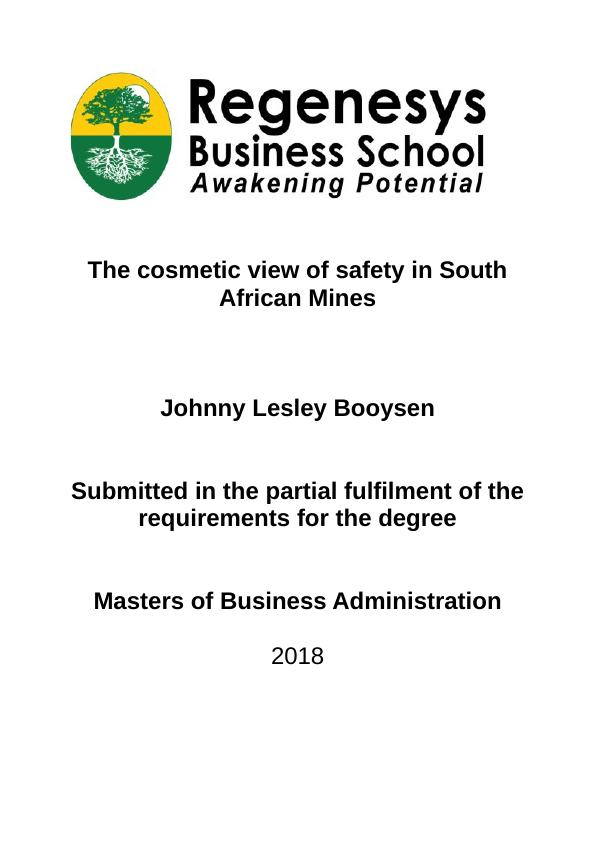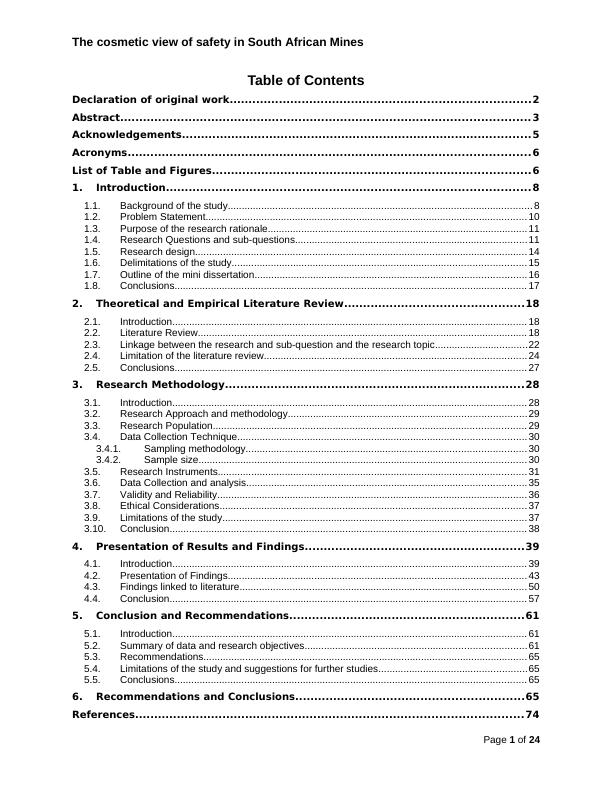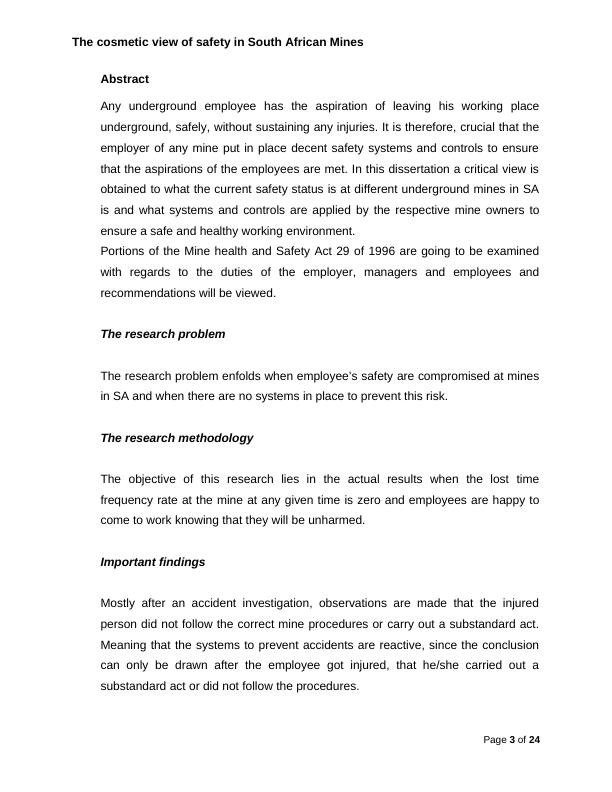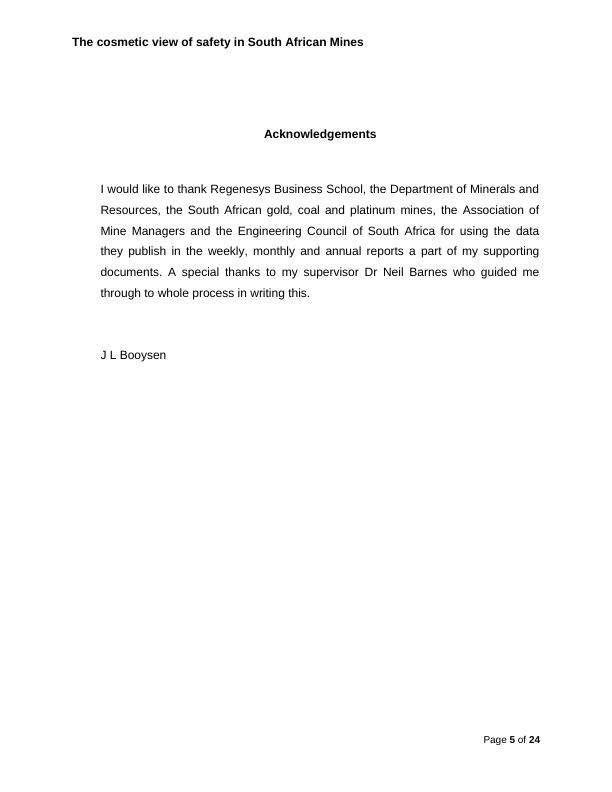The Cosmetic View of Safety in South African Mines
Added on 2022-12-22
24 Pages7663 Words3 Views
The cosmetic view of safety in South
African Mines
Johnny Lesley Booysen
Submitted in the partial fulfilment of the
requirements for the degree
Masters of Business Administration
2018
African Mines
Johnny Lesley Booysen
Submitted in the partial fulfilment of the
requirements for the degree
Masters of Business Administration
2018

The cosmetic view of safety in South African Mines
Table of Contents
Declaration of original work...............................................................................2
Abstract............................................................................................................ 3
Acknowledgements............................................................................................ 5
Acronyms.......................................................................................................... 6
List of Table and Figures....................................................................................6
1. Introduction................................................................................................ 8
1.1. Background of the study............................................................................................................. 8
1.2. Problem Statement................................................................................................................... 10
1.3. Purpose of the research rationale............................................................................................. 11
1.4. Research Questions and sub-questions...................................................................................11
1.5. Research design....................................................................................................................... 14
1.6. Delimitations of the study......................................................................................................... 15
1.7. Outline of the mini dissertation.................................................................................................16
1.8. Conclusions.............................................................................................................................. 17
2. Theoretical and Empirical Literature Review...............................................18
2.1. Introduction............................................................................................................................... 18
2.2. Literature Review...................................................................................................................... 18
2.3. Linkage between the research and sub-question and the research topic.................................22
2.4. Limitation of the literature review.............................................................................................. 24
2.5. Conclusions.............................................................................................................................. 27
3. Research Methodology...............................................................................28
3.1. Introduction............................................................................................................................... 28
3.2. Research Approach and methodology.....................................................................................29
3.3. Research Population................................................................................................................ 29
3.4. Data Collection Technique....................................................................................................... 30
3.4.1. Sampling methodology.................................................................................................... 30
3.4.2. Sample size..................................................................................................................... 30
3.5. Research Instruments.............................................................................................................. 31
3.6. Data Collection and analysis.................................................................................................... 35
3.7. Validity and Reliability............................................................................................................... 36
3.8. Ethical Considerations.............................................................................................................. 37
3.9. Limitations of the study............................................................................................................. 37
3.10. Conclusion................................................................................................................................ 38
4. Presentation of Results and Findings..........................................................39
4.1. Introduction............................................................................................................................... 39
4.2. Presentation of Findings........................................................................................................... 43
4.3. Findings linked to literature....................................................................................................... 50
4.4. Conclusion................................................................................................................................ 57
5. Conclusion and Recommendations..............................................................61
5.1. Introduction............................................................................................................................... 61
5.2. Summary of data and research objectives...............................................................................61
5.3. Recommendations.................................................................................................................... 65
5.4. Limitations of the study and suggestions for further studies.....................................................65
5.5. Conclusions.............................................................................................................................. 65
6. Recommendations and Conclusions............................................................65
References...................................................................................................... 74
Page 1 of 24
Table of Contents
Declaration of original work...............................................................................2
Abstract............................................................................................................ 3
Acknowledgements............................................................................................ 5
Acronyms.......................................................................................................... 6
List of Table and Figures....................................................................................6
1. Introduction................................................................................................ 8
1.1. Background of the study............................................................................................................. 8
1.2. Problem Statement................................................................................................................... 10
1.3. Purpose of the research rationale............................................................................................. 11
1.4. Research Questions and sub-questions...................................................................................11
1.5. Research design....................................................................................................................... 14
1.6. Delimitations of the study......................................................................................................... 15
1.7. Outline of the mini dissertation.................................................................................................16
1.8. Conclusions.............................................................................................................................. 17
2. Theoretical and Empirical Literature Review...............................................18
2.1. Introduction............................................................................................................................... 18
2.2. Literature Review...................................................................................................................... 18
2.3. Linkage between the research and sub-question and the research topic.................................22
2.4. Limitation of the literature review.............................................................................................. 24
2.5. Conclusions.............................................................................................................................. 27
3. Research Methodology...............................................................................28
3.1. Introduction............................................................................................................................... 28
3.2. Research Approach and methodology.....................................................................................29
3.3. Research Population................................................................................................................ 29
3.4. Data Collection Technique....................................................................................................... 30
3.4.1. Sampling methodology.................................................................................................... 30
3.4.2. Sample size..................................................................................................................... 30
3.5. Research Instruments.............................................................................................................. 31
3.6. Data Collection and analysis.................................................................................................... 35
3.7. Validity and Reliability............................................................................................................... 36
3.8. Ethical Considerations.............................................................................................................. 37
3.9. Limitations of the study............................................................................................................. 37
3.10. Conclusion................................................................................................................................ 38
4. Presentation of Results and Findings..........................................................39
4.1. Introduction............................................................................................................................... 39
4.2. Presentation of Findings........................................................................................................... 43
4.3. Findings linked to literature....................................................................................................... 50
4.4. Conclusion................................................................................................................................ 57
5. Conclusion and Recommendations..............................................................61
5.1. Introduction............................................................................................................................... 61
5.2. Summary of data and research objectives...............................................................................61
5.3. Recommendations.................................................................................................................... 65
5.4. Limitations of the study and suggestions for further studies.....................................................65
5.5. Conclusions.............................................................................................................................. 65
6. Recommendations and Conclusions............................................................65
References...................................................................................................... 74
Page 1 of 24

The cosmetic view of safety in South African Mines
Declaration of original work
I Johnny Lesley Booysen declare that this research report is my own, unaided
work. It is submitted in partial fulfilment of the requirements of the Master of
Business Administration degree at Regenesys Business School, Sandton, South
Africa. It has not been submitted before for any degree or examination at any other
university or educational institution
Student: Johnny Lesley Booysen Date: 07 November 2018
Page 2 of 24
Declaration of original work
I Johnny Lesley Booysen declare that this research report is my own, unaided
work. It is submitted in partial fulfilment of the requirements of the Master of
Business Administration degree at Regenesys Business School, Sandton, South
Africa. It has not been submitted before for any degree or examination at any other
university or educational institution
Student: Johnny Lesley Booysen Date: 07 November 2018
Page 2 of 24

The cosmetic view of safety in South African Mines
Abstract
Any underground employee has the aspiration of leaving his working place
underground, safely, without sustaining any injuries. It is therefore, crucial that the
employer of any mine put in place decent safety systems and controls to ensure
that the aspirations of the employees are met. In this dissertation a critical view is
obtained to what the current safety status is at different underground mines in SA
is and what systems and controls are applied by the respective mine owners to
ensure a safe and healthy working environment.
Portions of the Mine health and Safety Act 29 of 1996 are going to be examined
with regards to the duties of the employer, managers and employees and
recommendations will be viewed.
The research problem
The research problem enfolds when employee’s safety are compromised at mines
in SA and when there are no systems in place to prevent this risk.
The research methodology
The objective of this research lies in the actual results when the lost time
frequency rate at the mine at any given time is zero and employees are happy to
come to work knowing that they will be unharmed.
Important findings
Mostly after an accident investigation, observations are made that the injured
person did not follow the correct mine procedures or carry out a substandard act.
Meaning that the systems to prevent accidents are reactive, since the conclusion
can only be drawn after the employee got injured, that he/she carried out a
substandard act or did not follow the procedures.
Page 3 of 24
Abstract
Any underground employee has the aspiration of leaving his working place
underground, safely, without sustaining any injuries. It is therefore, crucial that the
employer of any mine put in place decent safety systems and controls to ensure
that the aspirations of the employees are met. In this dissertation a critical view is
obtained to what the current safety status is at different underground mines in SA
is and what systems and controls are applied by the respective mine owners to
ensure a safe and healthy working environment.
Portions of the Mine health and Safety Act 29 of 1996 are going to be examined
with regards to the duties of the employer, managers and employees and
recommendations will be viewed.
The research problem
The research problem enfolds when employee’s safety are compromised at mines
in SA and when there are no systems in place to prevent this risk.
The research methodology
The objective of this research lies in the actual results when the lost time
frequency rate at the mine at any given time is zero and employees are happy to
come to work knowing that they will be unharmed.
Important findings
Mostly after an accident investigation, observations are made that the injured
person did not follow the correct mine procedures or carry out a substandard act.
Meaning that the systems to prevent accidents are reactive, since the conclusion
can only be drawn after the employee got injured, that he/she carried out a
substandard act or did not follow the procedures.
Page 3 of 24

The cosmetic view of safety in South African Mines
This immediately trigger a lot of questions about the validity of the risk
identification and risk assessment process which need to be conducted before
normal operations can commence, the method used to ensure that the procedures
are understand and implemented, the training record of the injured person and his
colleagues, whether internal inspections or external audits where conducted and
why did it not pick up the non-compliance in the area also what instructions were
given to the now injured prior to the accident and what was expected from the
employee. It is also crucial that board of director’s review the Rand Mutual
insurance fund application since there are incidents whereby an employee will get
injured under suspicious circumstances to benefit from the fund.
Main conclusions
Safety is a state of mind and an accident is an undesired event which results in the
loss of life, production and or damage of equipment. A practical management
system will be to proactively inspect and audit the current status of the employee’s
safety and to put in place decent follow up systems to prevent reoccurrences.
The emphasis will not only lie in the implementation process of a safety
management programme but it relies on proactive inspections to prevent
employees from getting injured. It can also be concluded that the organisation lose
lots of money when the operation are halted due to an accident or safety
stoppages.
In a conventional platinum mine revenue generated, from a blast of one panel up
to 30 metres, can be as much as R160 000. Organisations can maximise their
revenue and gain competitive advantage over their competitors by improving their
accident statistics.
Page 4 of 24
This immediately trigger a lot of questions about the validity of the risk
identification and risk assessment process which need to be conducted before
normal operations can commence, the method used to ensure that the procedures
are understand and implemented, the training record of the injured person and his
colleagues, whether internal inspections or external audits where conducted and
why did it not pick up the non-compliance in the area also what instructions were
given to the now injured prior to the accident and what was expected from the
employee. It is also crucial that board of director’s review the Rand Mutual
insurance fund application since there are incidents whereby an employee will get
injured under suspicious circumstances to benefit from the fund.
Main conclusions
Safety is a state of mind and an accident is an undesired event which results in the
loss of life, production and or damage of equipment. A practical management
system will be to proactively inspect and audit the current status of the employee’s
safety and to put in place decent follow up systems to prevent reoccurrences.
The emphasis will not only lie in the implementation process of a safety
management programme but it relies on proactive inspections to prevent
employees from getting injured. It can also be concluded that the organisation lose
lots of money when the operation are halted due to an accident or safety
stoppages.
In a conventional platinum mine revenue generated, from a blast of one panel up
to 30 metres, can be as much as R160 000. Organisations can maximise their
revenue and gain competitive advantage over their competitors by improving their
accident statistics.
Page 4 of 24

The cosmetic view of safety in South African Mines
Acknowledgements
I would like to thank Regenesys Business School, the Department of Minerals and
Resources, the South African gold, coal and platinum mines, the Association of
Mine Managers and the Engineering Council of South Africa for using the data
they publish in the weekly, monthly and annual reports a part of my supporting
documents. A special thanks to my supervisor Dr Neil Barnes who guided me
through to whole process in writing this.
J L Booysen
Page 5 of 24
Acknowledgements
I would like to thank Regenesys Business School, the Department of Minerals and
Resources, the South African gold, coal and platinum mines, the Association of
Mine Managers and the Engineering Council of South Africa for using the data
they publish in the weekly, monthly and annual reports a part of my supporting
documents. A special thanks to my supervisor Dr Neil Barnes who guided me
through to whole process in writing this.
J L Booysen
Page 5 of 24

End of preview
Want to access all the pages? Upload your documents or become a member.